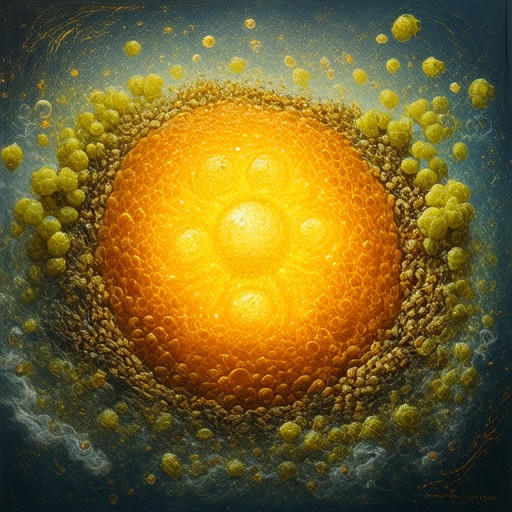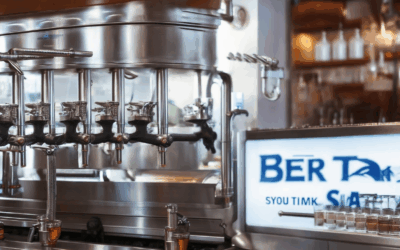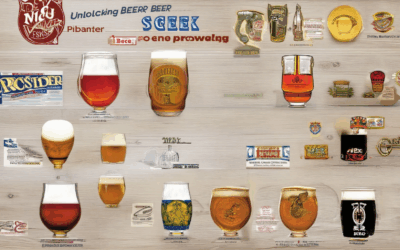Beer is more than just a refreshing beverage—it’s a complex blend of artistry, science, and tradition that reveals its secrets through every sip. Understanding the intricate structures of beer allows us to appreciate its rich history, diverse flavors, and the craftsmanship that goes into crafting it. From the molecular composition to the chemical interactions, beer’s structure plays a pivotal role in shaping its taste, aroma, and overall experience. In this article, we’ll delve into the key components that make up beer, explore the essential elements that define its structure, and uncover the molecular and chemical makeup that gives it its unique profile. Whether you’re a casual beer enthusiast or a curious learner, this guide will provide you with a comprehensive understanding of what makes beer truly special.
Key Takeaways
- Malt is the backbone of beer, providing fermentable sugars and influencing body, flavor, and color.
- Hops add bitterness and aromatic notes, balancing malt sweetness and extending shelf life.
- Yeast is essential for fermentation, converting sugars into alcohol and carbon dioxide, affecting flavor and mouthfeel.
- Water plays a crucial role in beer’s taste, contributing minerals that complement malt and hops.
- The interplay of malt, hops, yeast, and water allows for endless beer styles, from lagers to stouts.

Key Components of Beer
Beer is composed of several essential ingredients that work together to create its unique flavor, aroma, and appearance. Here’s a breakdown of the primary components:
1. Water
- The base of beer, water makes up approximately 90% of the volume.
- Its role is crucial in determining the beer’s body and taste.
- Soft water is preferred for a smoother finish, while hard water can affect the bitterness.
2. Malted Barley
- A staple in almost every beer, malted barley provides the fermentable sugars needed for alcohol production.
- It adds body, sweetness, and a rich malt flavor.
- Different types of barley (e.g., Pale Ale, Munich) are used to achieve varying levels of sweetness and color.
3. Hops
- Hops are added during the brewing process for flavor, aroma, and preservation.
- They contribute bitterness, which balances the sweetness of the malt.
- Hops also add floral or citrusy notes depending on variety and usage.
4. Yeast
- Yeast is the catalyst for fermentation, converting sugar into alcohol and carbon dioxide.
- Different yeast strains (e.g., Ale, Lager) influence the beer’s flavor profile and fermentation speed.
- Proper yeast health and activity are critical for a successful brew.
5. Optional Flavorings
- Ingredients like fruits, spices, or coffee can be added for unique beer profiles.
- Common additions include coriander, orange peel, or fruit juices for complexity.
- These flavors complement the base ingredients while offering diversity in beer styles.
6. Other Ingredients
- Some beers may include sugars, honey, or molasses for additional sweetness.
- Amino acids and proteins from grains can enhance mouthfeel and head retention.
- Processing aids and stabilizers are used to improve clarity and shelf life.
Brewing Process Overview
- The combination of these ingredients undergoes several steps: mashing, boiling, fermentation, conditioning, and aging.
- Each step influences the final product’s characteristics, ensuring a consistent and high-quality beer.
By carefully selecting and balancing these components, brewers can craft a wide range of beer styles, each offering unique sensory experiences and complexities.
What Are the Essential Components That Define the Structure of Beer?
The structure of beer is defined by four primary components that work together to create its unique flavor, aroma, and appearance. These components are:
- Malt : Malt is the backbone of beer and provides the majority of its flavor and sweetness. It is made from starch-rich grains like barley, which are germinated and dried before being used. Malt contributes sugars during fermentation and adds body and depth to the beer.
- Hops : Hops are the spice of beer, adding bitterness, flavor, and aromatic qualities. They also act as a preservative. Hops are added during the brewing process and come in various varieties, each contributing distinct characteristics to the final beer.
- Yeast : Yeast is the catalyst for fermentation, converting the sugars from malt into alcohol and carbonation. Different yeast strains can greatly influence the flavor profile, mouthfeel, and overall character of the beer.
- Water : Water is the most abundant component of beer and plays a crucial role in determining the beer’s taste and mouthfeel. The mineral content of the water, along with the choice of malt and hops, helps shape the beer’s personality.
These ingredients are carefully balanced by brewers to create a harmonious flavor profile and a consistent product. The interaction between these components is what makes beer such a versatile and enjoyable beverage.
Explore Craft Breweries | Learn About Beer Styles

Understanding the Molecular Structure of Beer
Beer is a fascinating beverage with a rich molecular composition that contributes to its unique flavor, aroma, and texture. At its core, beer is made from four primary ingredients: malted barley, water, hops, and yeast. Each of these ingredients plays a crucial role in shaping the molecular structure of beer.
1. Malted Barley
Malted barley is the foundation of beer. It consists of starches, proteins, and enzymes that undergo several transformations during brewing. The starches in malted barley are converted into fermentable sugars through a process called malting. This conversion is facilitated by enzymes such as alpha-amylase and beta-glucanase, which break down the cellular walls of the barley kernels and release sugars like dextrin, maltose, and glucose. These sugars become the fuel for yeast fermentation, leading to the production of alcohol.
2. Hops
Hops are added to beer for their flavor-enhancing properties and as a natural preservative. They contain compounds like hop resins, essential oils, and antioxidants. Hops contribute floral, citrusy, and pine-like flavors to beer. Essential oils such as myrcene and humulene are responsible for these aromatic notes. Additionally, hops possess antimicrobial properties that help preserve the beer, reducing the risk of spoilage.
3. Yeast
Yeast is the catalyst for fermentation, converting the sugars derived from malted barley into alcohol and carbonating the beer. The most commonly used yeast in commercial brewing is Saccharomyces cerevisiae . During fermentation, yeast metabolizes sugars, producing ethanol and carbon dioxide. The carbon dioxide escapes as bubbles, while the ethanol becomes the primary alcoholic content of the beer.
4. Water
Water is the third key ingredient in beer and significantly influences its taste. The mineral content of water, particularly hardness (levels of calcium, magnesium, and bicarbonate), affects the mouthfeel and flavor of beer. Hard water can impart a smoother texture, while soft water may emphasize bitterness.
5. Fermentation Process
The fermentation process involves several biochemical reactions. Yeast cells consume oxygen during the initial phase of fermentation, known as the aerobic phase, which enhances the production of ATP and other necessary metabolites. As fermentation progresses, yeast switches to anaerobic conditions, where glycolysis occurs, converting glucose into pyruvate, which is then transformed into ethanol and carbon dioxide.
6. Post-Fermentation Developments
After fermentation, beer undergoes conditioning, such as cold storage, to enhance clarity and flavor stability. In some cases, additional processes like sparging (rinsing malt with hot water) and boiling are employed to remove impurities and concentrate flavors.
7. Health Considerations
Beer contains various organic compounds, including antioxidants from hops, which may contribute to its potential health benefits. However, moderation is advised due to its alcohol content.
In summary, the molecular structure of beer is a complex interplay of carbohydrates from malted barley, aromatic compounds from hops, and yeast-derived alcohols. This intricate blend creates the distinct characteristics that make beer enjoyable to millions of people worldwide.

Foundational Elements of Beer
Beer is composed of several key ingredients and processes that work together to create its unique flavor, aroma, and appearance. Here’s a breakdown of the primary components that define the structure of beer:
- Malt :
Malt is the backbone of beer production. It is derived from barley, wheat, rye, or other grains and is responsible for providing the fermentable sugars that yeast needs to convert into alcohol. The type of malt used significantly influences the beer’s body, flavor, and color. For instance, pale ale malt creates a light, crisp beer, while wheat malt contributes to a hazy, creamy texture. - Hops :
Hops are the flowers of the hop plant and play a dual role in beer. They add bitterness, which balances the sweetness of malt, and contribute floral or citrusy aromas. Different hop varieties (e.g., Amarillo, Simcoe, or Willamette) bring distinct characteristics to the beer. Hops also act as a preservative, helping to extend the beer’s shelf life. - Yeast :
Yeast is the microorganism responsible for fermentation. It converts the sugars from malt into alcohol and carbon dioxide, giving beer its effervescence. The strain of yeast used (e.g., Ale yeast or Lager yeast) impacts the beer’s flavor profile and fermentation speed. Some beers may also undergo bottle conditioning, where yeast is added later to enhance flavor and mouthfeel. - Water :
Water is the fourth key ingredient and plays a crucial role in determining the beer’s taste and head retention. The mineral content of water, combined with the malt and hops, creates the beer’s flavor profile. Soft water tends to produce beers with a smoother finish, while hard water can result in a more assertive, mineral-driven taste.
These four elements—malt, hops, yeast, and water—work together to create the complex flavors, aromas, and textures that make beer unique. The careful balance of these components is what gives craft brewers the ability to create a wide variety of beer styles, from lagers and ales to stouts and porters.
Foundational Elements of Beer
Beer is composed of several key ingredients and processes that work together to create its unique flavor, aroma, and appearance. Here’s a breakdown of the primary components that define the structure of beer:
- Malt :
Malt is the backbone of beer production. It is derived from barley, wheat, rye, or other grains and is responsible for providing the fermentable sugars that yeast needs to convert into alcohol. The type of malt used significantly influences the beer’s body, flavor, and color. For instance, pale ale malt creates a light, crisp beer, while wheat malt contributes to a hazy, creamy texture. - Hops :
Hops are the flowers of the hop plant and play a dual role in beer. They add bitterness, which balances the sweetness of malt, and contribute floral or citrusy aromas. Different hop varieties (e.g., Amarillo, Simcoe, or Willamette) bring distinct characteristics to the beer. Hops also act as a preservative, helping to extend the beer’s shelf life. - Yeast :
Yeast is the microorganism responsible for fermentation. It converts the sugars from malt into alcohol and carbon dioxide, giving beer its effervescence. The strain of yeast used (e.g., Ale yeast or Lager yeast) impacts the beer’s flavor profile and fermentation speed. Some beers may also undergo bottle conditioning, where yeast is added later to enhance flavor and mouthfeel. - Water :
Water is the fourth key ingredient and plays a crucial role in determining the beer’s taste and head retention. The mineral content of water, combined with the malt and hops, creates the beer’s flavor profile. Soft water tends to produce beers with a smoother finish, while hard water can result in a more assertive, mineral-driven taste.
These four elements—malt, hops, yeast, and water—work together to create the complex flavors, aromas, and textures that make beer unique. The careful balance of these components is what gives craft brewers the ability to create a wide variety of beer styles, from lagers and ales to stouts and porters.

The Chemical Structure of Beer
Beer is composed of several key chemical components that contribute to its unique flavor, aroma, and appearance. Here’s a breakdown of its primary ingredients and the processes that shape its chemical structure:
- Malt Extract : Malted barley is the foundation of beer, providing a rich source of carbohydrates (starches) that are converted into sugars during the brewing process. These sugars serve as the primary energy source for the fermentation process.
- Yeast : The active ingredient in beer fermentation, yeast (commonly Saccharomyces cerevisiae ) converts the sugars into alcohol and carbon dioxide gas. This process is known as alcoholic fermentation.
- Hops : Hops are added during the brewing process for their flavor, aroma, and preservative properties. They contain compounds like alpha acids (which contribute bitterness) and essential oils (which contribute aroma).
- Water : Water makes up approximately 90% of beer by weight. The mineral content of water can significantly influence the flavor profile of beer, affecting its mouthfeel and taste.
- Fermentation Byproducts : During fermentation, yeast produces ethanol, carbon dioxide, and other byproducts that contribute to the beer’s character. These byproducts include esters, ketones, and other organic compounds that add complexity to the flavor and aroma.
- Post-Fermentation Processing : After fermentation, beer undergoes conditioning, which may include cold storage to enhance flavor stability and clarification. This process helps to remove any residual solids and impurities.
Key Chemical Components:
- Carbohydrates : Dominant component from malted barley, converted into sugars during the mashing process.
- Proteins : Present in malt and hops, contributing to the beer’s body and head retention.
- Lipids : Found in hops, contributing to foam stability and flavor.
- Phenols : Compounds from hops that contribute to the beer’s aroma and bouquet.
- Terpenoids : Aromatic compounds from hops that add complexity to the nose.
Brewing Process Impact:
- Malting : The process of converting raw barley into malted barley affects the availability of starches and proteins, influencing the final beer’s chemical profile.
- Brewing Techniques : Variables such as the type of malt, hop usage rate, and yeast strain can significantly alter the chemical structure and flavor of the beer.
Conclusion:
The chemical structure of beer is a harmonious blend of sugars, alcohol, carbonation, and aromatic compounds. Each component plays a vital role in creating a balanced and flavorful beverage that appeals to a broad range of preferences.





0 Comments